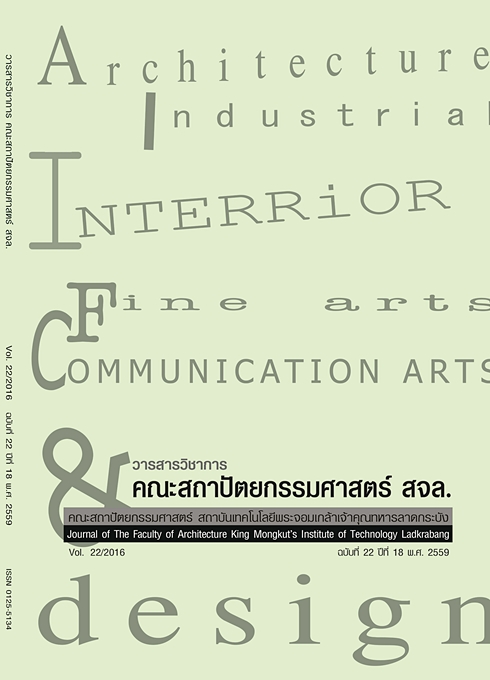ภูมิทัศน์วัฒนธรรมของเวียดนามที่ได้รับอิทธิพลจากวัฒนธรรมจีนและฝรั่งเศส The Cultural Landscape of Vietnam, Received Chinese and French Influences
Main Article Content
Abstract
บทคัดย่อ
การศึกษาลักษณะภูมิทัศน์วัฒนธรรมของเวียดนามที่ได้รับอิทธิพลมาจากการปกครองของจีนและฝรั่งเศส โดยศึกษาจากงานวิจัยและบทความที่เกี่ยวข้อง เก็บข้อมูลโดยการสำรวจและการสังเกตพบว่าเวียดนามอยู่ภายใต้การปกครองของจีนมาตั้งแต่สมัยราชวงศ์ฮั่น (140-86 ปีก่อนคริสต์ศักราช) จนถึงช่วงของจักรพรรดิซาลองและจักรพรรดิ
หมินหมั่ง เวียดนามมีการรับรูปแบบวัฒนรรมของจีนมาอย่างต่อเนื่อง ทั้งระบบการปกครอง จารีตประเพณี คติความเชื่อในลัทธิขงจื้อ เกิดเป็นภูมิทัศน์วัฒนธรรมตามแบบอิทธิพลจีน ได้แก่ การใช้ตัวอักษรจีน การเซ่นไหว้และการเคารพบรรพบุรุษ รูปแบบการวางผังและการจัดภูมิทัศน์ในพระราชวัง “เว้” ตามแบบแผนการวางผังของพระราชวังต้องห้ามของจีน มีการสร้างสุสานจักรพรรดิเป็นต้น จากนั้นเวียดนามได้รับ อิทธิผลจากฝรั่งเศสในช่วงคริสตวรรษที่ 19 ส่งผลต่อระบบการเมืองการปกครอง ระบบการศึกษาของเวียดนามเป็นอย่างมาก โดยมีการเปลี่ยนมาใช้ตัวอักษร “กว๊วก” แทนอักษรจีน รวมถึงการวางผังและการตัด ถนนแบบมีเส้นแกนตามแบบของฝรั่งเศส และพบเห็นลักษณะของสถาปัตยกรรมที่มีซุ้มประตูหน้าหน้าต่างแบบโค้งในสถานที่ราชการโบสถ์ รวมถึงที่พักอาศัยของประชาชน แต่ลักษณะดังกล่าวพบในเมืองใหญ่เท่านั้น ไม่พบในเขตชนบทบนที่ราบสูงซึ่งเป็นที่อยู่อาศัยของคนกลุ่มน้อย เพราะอิทธิพลจากการปกครองเข้าไปไม่ถึง ทำให้ลักษณะของที่อยู่อาศัยบริเวณชนบทและที่ราบสูงยังคงรูปแบบที่เป็นเอกลักษณ์เฉพาะตัว รวม
ถึงภูมิทัศน์ที่อยู่โดยรอบ เช่น พื้นที่เกษตรกรรม และวิถีชีวิตของ “การทำนา” ยังคงรูปแบบของภูมิทัศน์วัฒนธรรมของเวียดนามอย่างชัดเจนเพราะเป็นวัฒนธรรมที่ฝังรากลึกและถ่ายทอดจากรุ่นสู่รุ่นมาจนถึง
ปัจจุบัน
คำสำคัญ: ภูมิทัศน์วัฒนธรรม เวียดนาม อิทธิพล
Abstract
This research aimed to study the cultural landscape of Vietnam, received Chinese and French influences.Research methodology included literature reviews, survey and observation. The research found that Vietnam was under Chinese administration since Han dynasty (140-86 BC) until Salon Emperor and Minh Mang Emperor. Therefore, Vietnam had altered their culture according to the Chinese one constantly, including public administration, custom and traditions, norms and believes, especially Confucius, hence the Chinese cultural
landscape had emerged. This included Chinese alphabet, ancestor worship ceremony, Weh royal palace planning and landscape influenced by Chinese Forbidden City, and Emperor’s mausoleum. Since 19th century, Vietnam had changed to French influence, including public administration and education, especially the replacement of Kwak to the Chinese alphabet, grid city planning, and arch shape application in door and windows of public buildings, churches and housing. This French building ornament could be found only in larch cities, not in village or high land areas where their indigenous building forms and landscape still preserved, like agriculture and paddy field. The Vietnamese cultural landscape had been obvious here and transferred from one to the next generation.
Keywords: Cultural Landscape Vietnam Influences
Article Details
This work is licensed under a Creative Commons Attribution-NonCommercial-ShareAlike 4.0 International License.
Copyright Transfer Statement
The copyright of this article is transferred to Journal of The Faculty of Architecture King Mongkut's Institute of Technology Ladkrabang with effect if and when the article is accepted for publication. The copyright transfer covers the exclusive right to reproduce and distribute the article, including reprints, translations, photographic reproductions, electronic form (offline, online) or any other reproductions of similar nature.
The author warrants that this contribution is original and that he/she has full power to make this grant. The author signs for and accepts responsibility for releasing this material on behalf of any and all co-authors.


